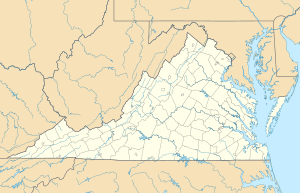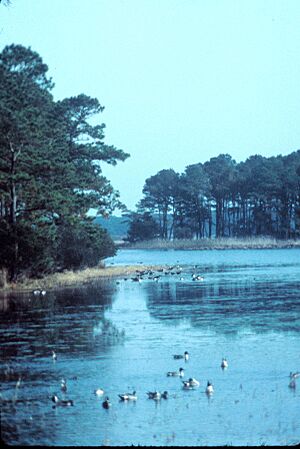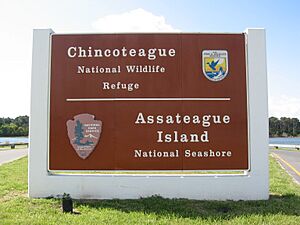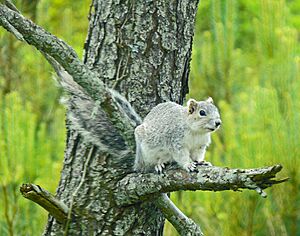Chincoteague National Wildlife Refuge facts for kids
Quick facts for kids Chincoteague National Wildlife Refuge |
|
|---|---|
|
IUCN Category IV (Habitat/Species Management Area)
|
|
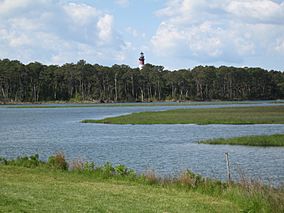
Assateague Channel with Assateague Light in the distance
|
|
| Location | Accomack County, Virginia / Worcester County, Maryland |
| Nearest city | Chincoteague, Virginia |
| Area | 14,000 acres (57 km2) |
| Established | 1943 |
| Governing body | U.S. Fish & Wildlife Service |
| Website | Chincoteague National Wildlife Refuge |
The Chincoteague National Wildlife Refuge is a special place that protects wildlife. It covers about 14,000 acres (57 square kilometers). The U.S. Fish & Wildlife Service takes care of it. Most of the refuge is on the Virginia part of Assateague Island. A small part is in Maryland, and it also includes Morris Island and Wildcat Marsh. This refuge is home to many different animals and birds. You might even spot the famous Chincoteague Pony here! The main goal of the refuge is to keep animals, plants, and their homes safe for everyone, now and in the future.
Contents
History of Chincoteague Refuge
Have you heard about the wild ponies of Assateague Island? A popular story says they came from a Spanish galleon (a large sailing ship) that sank long ago. The ponies supposedly swam to shore. But historians think something different happened. In the 1600s, settlers might have brought livestock to the island. This helped them avoid rules about fences and taxes. No one is completely sure how the ponies arrived. But their descendants still live on the island today!
The island is also known for shipwrecks. One famous shipwreck involved a yacht called the Dispatch in 1891. President Harrison was on board. The ship's lieutenant mistook a lighthouse's glow for another light. This caused the yacht to go off course and get stuck. Luckily, everyone on board was safe.
Assateague Lighthouse History
The Assateague Lighthouse was built in 1833. Its job was to warn ships about dangerous sandbars offshore. A stronger brick lighthouse was planned, but the Civil War stopped the work. Building started again after the war. The new lighthouse was finished in 1867.
Over the years, the lighthouse changed. An assistant keeper's house was built in 1910. In 1933, an electric lamp replaced the old oil lamp. In 2004, the U.S. Coast Guard gave the lighthouse to the U.S. Fish and Wildlife Service. The Coast Guard still maintains the light. The Chincoteague National Wildlife Refuge now protects the lighthouse itself. Restoration work on the lighthouse began in 2008. The Assateague Island lighthouse is an important historical site.
Assateague Village
When the lighthouse was being built, a small community called Assateague Village grew up. In 1915, about 25 to 30 families lived there. This didn't include the lighthouse keepers. Around 1922, people started leaving the village. This happened after Dr. Samuel B. Fields bought most of the land on the Virginia side. He fenced off his land. This stopped villagers from reaching Toms Cove.
Because Toms Cove was blocked, families began to move away. Their houses were lifted onto skids. Then they were moved to the waterfront. From there, they were placed on barges and taken to Chincoteague Island. Bill Scott, who ran the village's only store, was the last to leave. In 1943, the S.B. Fields family sold their land to the U.S. Government. This land then became the National Wildlife Refuge.
Activities at the Refuge
Hunting and Wildlife Management
The main goal of the Chincoteague National Wildlife Refuge is to keep all species safe. Sometimes, there are too many animals of a certain kind. Hunting helps control these populations. This is especially true for some big game and waterfowl. The refuge uses a permit system for hunting. You can find specific rules from the Virginia Department of Game & Inland Fisheries.
Visitors Center
The Herbert H. Bateman Educational and Administrative Center opened in 2003. Visitors can go there to buy passes and get maps. You can also ask staff members questions. The center was built using green energy. Geothermal energy heats and cools the building. Solar panels on the roof also provide power. The floors and ceiling are made from recycled materials. These include tires, bamboo, and aspen wood.
Inside the center, you'll find many exhibits. They teach visitors about the refuge's history. You can also learn about the plants and animals that live there. The center is open every day. Hours are 9 a.m. to 4 p.m. in spring, fall, and winter. In summer, it's open from 9 a.m. to 5 p.m.
General Rules for Visitors
Here are some things you can do at the refuge:
- Boats are allowed in certain areas.
- You can ride bicycles.
- Fishing, clamming, and crabbing are allowed in specific spots. You need a state fishing license. There are also rules about seasons and limits.
- Swimming is allowed in the ocean and in Tom's Cove.
- Horseback riding is allowed in special areas.
- Mopeds and motorized scooters can be used only on Beach Road.
- Oversand vehicles (OSVs) can be used in OSV zones with a permit.
Here are some things you cannot do:
- Fires or fireworks are not allowed. You need a special permit for beach parties.
- Skateboards or roller skates are not allowed.
- Camping is not allowed here. (But you can camp on the Maryland side of Assateague Island.)
- Pets are not allowed.
- Alcohol is not allowed.
- Do not disturb or collect plants, animals, or old items. You can collect empty shells. But please limit it to one gallon or less per person per day. You cannot sell the shells you collect.
- Do not feed or bother wildlife. Feeding animals can make them lose their fear of humans. This makes them more likely to get hurt by traffic. Human food can also make animals sick.
Geography of the Refuge
Chincoteague National Wildlife Refuge is at the southern end of Assateague Island. Assateague is a long, narrow barrier island. It runs along the east coast from Maryland down to Virginia. Chincoteague Bay is between Assateague Island and the Delmarva Peninsula. A smaller bay, Assateague Bay, separates Assateague Island from Chincoteague Island.
The wildlife refuge has many different environments. These include beaches, forests, and marshes. Thousands of living things call this place home. Because the island has so many different natural areas, it's very important for protecting and bringing back many species. Assateague Island is closer to the Atlantic Ocean than the mainland. So, it often feels the full power of tropical storms first. It acts like a shield for the mainland. It helps weaken storms and stops them from bringing too much moisture inland.
Climate
The weather at Chincoteague National Wildlife Refuge changes with the seasons. In summer (June to September), the average high temperature is between 81 °F (27 °C) and 85 °F (29 °C). The average low is between 63 °F (17 °C) and 68 °F (20 °C). In spring and fall, the average high is about 64 °F (18 °C). The average low is around 47 °F (8 °C). Winter has an average high of about 51 °F (11 °C). The average low is around 34 °F (1 °C).
Rainfall averages about 3.68 inches (93 mm) each month. It usually rains most in spring and fall. July is usually the warmest month. The highest temperature ever recorded was 102 °F (39 °C) in 1999. In summer, it can feel extra hot because of the humidity (moisture in the air). January is usually the coldest month. The lowest temperature ever recorded was −2 °F (−19 °C) in 1982.
Ecology: Habitats of Chincoteague
Chincoteague Refuge has many different habitats. These range from sandy beaches to wet marshes.
Beach Environment
Beach plants like the seabeach amaranth grow in tough conditions. They face shifting sands, little fresh water, salt water, and strong winds. Sometimes, the whole beach area can be covered by tidal surges (large waves from storms). The beach is very important for feeding hundreds of thousands of shorebirds. These birds visit the area every year during their migration. Shorebirds on the beach often become food for peregrine falcons.
Freshwater Areas
Assateague Island has wetlands that are mostly brackish (a mix of fresh and salt water). Plants that don't like much salt water grow here. Some parts of the refuge have man-made freshwater areas. These are called "moist soil management units" or "impoundments." There are fourteen of these areas, covering about 2,623 acres. They provide plants and food for waterfowl and other water birds.
Shrub Areas
This area stretches north and south on the flat parts of the island behind the dunes. The shrubs slowly blend with dune grasses closer to the beach. To the west, they meet marshes or forests. This habitat is home to many migrating and nesting songbirds. It's also a stop for migrating monarch butterflies.
Maritime Forest
The forest is home to animals like the endangered Delmarva fox squirrel, white-tailed deer, sika deer, and raccoons. These forests grow in large groups on old sand dunes. They are west of the shrub areas and impoundments. These parts of the island have been the most stable over time.
Dunes
The sand dunes are like a natural wall against storm surges. They protect other wildlife habitats from being flooded by salt water. The dunes are also nesting areas for the threatened piping plover and other shorebirds. Many creatures live in the sand dunes, such as the ghost crab, red fox, and raccoons. These areas might look empty, but many animals are just hiding to avoid predators.
Salt Marshes
The regular flooding from the tides affects where salt marsh plants grow. These salt marshes are found west of the barrier islands. They are home to black ducks, clapper rails, and other species.
Animals of Chincoteague
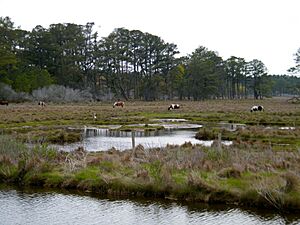
- Merlin (Falco columbarius): The merlin is a type of falcon that lives on Assateague Island. Merlins are known to pretend to be other birds, like a pigeon or woodpecker, to surprise their prey. They can also be very protective of their territory, even against other birds of prey.
- Piping plover (Charadrius melodus): Piping plovers travel between the United States and the Gulf of Mexico. They come to Assateague State Park to lay their eggs. Raccoons, gulls, or foxes sometimes eat piping plover eggs.
- Brown pelican (Pelecanus occidentalis): Brown pelicans are amazing hunters. They use their huge bill and stretchy pouch to dive into the water and catch fish. They eat about 4 pounds (1.8 kg) of fish every day. These pelicans lay two to four eggs after mating. They usually live in large groups called colonies.
- Sika deer (Cervus nippon): Sika deer usually live in the sand dunes and marshes on Assateague. They originally came from Japan or eastern Asia. They sometimes act like larger North American Elk. During mating season, male sika deer can have impressive battles. There are many types of sika deer in Asia. Some have become extinct, so they have been moved to other parts of the world to help their populations grow.
- Red fox (Vulpes vulpes): Red foxes are usually active at night on Assateague. You might spot them on the shoreline. They have very good hearing. This helps them find prey like mice hiding under snow or sand. They are good at controlling rodent populations. Red foxes usually don't live very long, but some have lived up to 14 years.
- Atlantic horseshoe crab (Limulus polyphemus): Horseshoe crabs have changed very little in 200 million years! They mostly live in calm, shallow waters near the shore. This animal is a marine arthropod (like an insect or spider), not a true crab. It looks a bit like a spider because it has many pairs of eyes. Horseshoe crabs eat razor clams and other shellfish. Many shorebirds, trout, flounder, and true crabs hunt them.
- Black skimmer (Rynchops niger): Black skimmers are special hunters because of their unique beaks. The lower part of their beak is longer than the upper part. They use it to skim across the water's surface. This scoops up any fish that aren't paying attention. This bird is currently listed as a threatened species. They usually breed in groups on beaches and lay about three to five eggs.
- Wild ponies: The Virginia herd of ponies belongs to the Chincoteague Volunteer Fire Company. They hold a carnival during Pony Penning to raise money. Each year, the Virginia ponies are rounded up for the pony penning and auction. Pony Penning started as a way for livestock owners to gather their loose animals. By the 1700s, it became an annual event. Pony Penning happens in July during the Chincoteague Volunteer Fireman's Carnival.


